JDC Literature Review
The JDC literature review contains summaries of recent publications and academic scholarship on issues relating to forced displacement.
Integration of Venezuelan Refugees and Migrants in Brazil
Brazil is hosting over 260,000 Venezuelans as of the second quarter of 2020. The majority of Venezuelan refugees and migrants enter and settle in the northern localities of Roraima (50 percent) and Amazonas (19 percent) bordering Venezuela. Brazil’s legal framework...
How Are Forcibly Displaced People Affected by the COVID-19 Pandemic Outbreak? Evidence From Brazil
This article examines how the COVID-19 pandemic has affected forcibly displaced people in Brazil, by considering their intersectional multiple identities. Intersectionality refers to the multiple, overlapping social identities of an individual (such as gender, social...
Gender-Based Violence and Violence Against Children: Prevention and Response Services in Uganda’s Refugee-Hosting Districts
Uganda hosts 1.4 million refugees, 81 percent of whom are women and children who are at high risk of gender-based violence (GBV) and violence against children (VAC), including sexual exploitation and abuse, rape, forced and child marriage, and intimate partner...
Deconstructing borders: Mobility strategies of South Sudanese refugees in northern Uganda
Uganda currently hosts more than 880,000 South Sudanese refugees, mostly in its northern districts. Refugees are permitted to work and move freely, and consequently there is interaction with surrounding host communities. Refugees are also free to settle independently...
Targeting humanitarian aid using administrative data: model design and validation
This paper presents the design and validation of an econometric model that uses routinely collected administrative data to target unconditional cash and in-kind assistance to Syrian refugees in Lebanon. The authors compare the prediction accuracy of the proposed model...
Empowering refugees through cash and agriculture: A regression discontinuity design
This article assesses the impact of the development approach promoted in the Kalobeyei refugee settlement in Turkana County in Northwest Kenya. Opened in 2016 just 3.5 kilometers from the Kakuma refugee camp, the Kalobeyei refugee settlement was envisaged as a model...
Local governance quality and the environmental cost of forced migration
This paper examines whether high-quality local governance can alleviate the environmental impact of large-scale refugee migration to Turkey. In the absence of additional investments in infrastructure and other waste management facilities, a greater population density...
Give me your tired and your poor: Impact of a large-scale amnesty program for undocumented refugees
This article examines the labor market impacts of the Permiso Especial de Permanencia (PEP) granted to nearly half a million undocumented Venezuelans in Colombia in August 2018. PEP is a resident visa (renewable every two years) that permits the holder to work and to...
Localising public health: Refugee-led organizations as first and last responders in COVID-19
Organizations created and led by refugees themselves (‘refugee-led organizations’, RLOs) play an important role in meeting community needs. In particular, refugee-led social protection (activities designed to reduce poverty, vulnerability, or risk), provided by...
The effect of refugees on native adolescents’ test scores: quasi-experimental evidence from PISA
This paper investigates the impact of Syrian refugees on the school performance of adolescent children in Turkey. Earlier research suggests that immigration may affect native children’s school performance through two main mechanisms that operate in opposite...


